Sugar-Ant-Free Home (Only These 2 Ways Work!)
Sugar ants are relatively mild-mannered compared to other ants, and they do not have stingers.
However, a sugar ant colony that decides to call your house their home becomes a pest – when they share the kitchen and living space with you and waste no time making an appearance each time you left drink spills unattended and food exposed.
How do you get rid of sugar ants effectively, so they don’t make a comeback?
Understanding some quick information on what attracts sugar ants and where to locate them will help you get rid of sugar ants decisively.
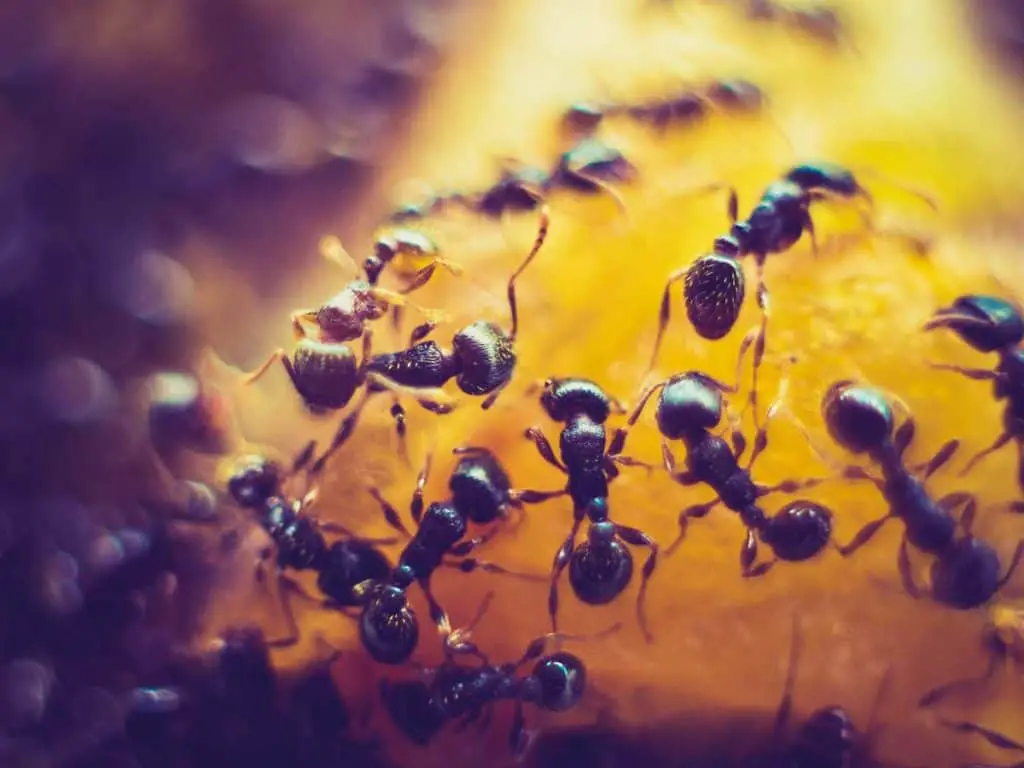
What Attracts Sugar Ants?
It is no secret that sugar ants love sugary and sweet foods. They are not picky eaters either – give them access to any protein-rich foods such as meats and cheese, and the worker ants will appear in droves.
Specifically, these conditions in your home will attract sugar ants:
- Food crumbs and sugary bits you drop on the kitchen countertop, floor, sofa, or bed.
- Loosely tied bags of sweet foods.
- Leftover pet food that you leave unattended after your pet’s meal.
- Sugary drink spills.
- Rotten fruits in the kitchen.
Where Do Sugar Ants Nest?
Sugar ants can nest indoors or outdoors near their food source.
You typically find sugar ant nests in these places:
- Hollowed tree trunks and branches.
- Under rocks.
- Potted plants.
- Behind or under kitchen cabinets.
- Within wall cavities.
- Wooden roof structures.
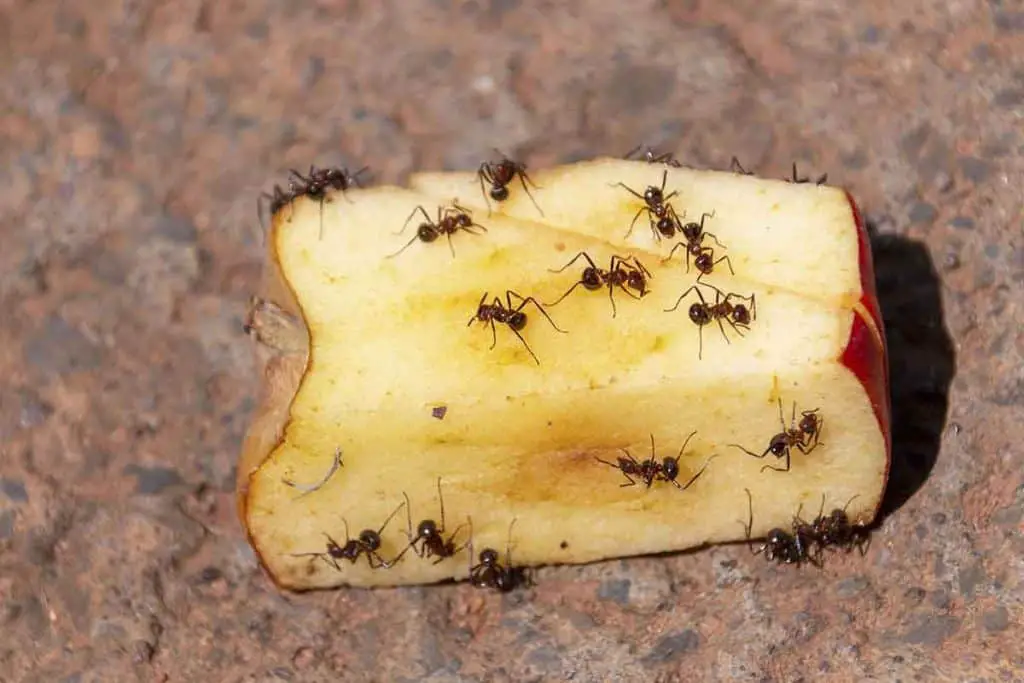
The 2 METHODS TO GET RID OF SUGAR ANTS
Forget the citric or essential oils scenting methods to deter sugar ants or household items (listed in a section towards the end of the post) that only kill the ants on contact.
If you want to get rid of sugar ants effectively, employing any of the two methods explained below will kill the entire colony in the nest.
Both methods adopt the same approach – one is a DIY homemade poison bait and the other a hassle-free ready-made bait you buy off the shelf (or online).
1. Borax and Brown Sugar Poison Bait
You want to make a liquid bait and place it in a plastic container with a lid that the sugar ants can get to but not your pets.
For the DIY ant bait, you need:
- Disposable plastic container with a lid (get more if you want multiple bait stations).
- Borax powder.
- Brown sugar.
- Warm water.
- Bread, cookies, or waffle.
Make the borax and sugar poison ant bait with these steps:
- Mix 1 teaspoon of borax powder and 4 teaspoons of brown sugar in a bowl.
- Add 4 oz warm water into the bowl and stir well.
- Drill or punch 3 equally-spaced holes through the wall of the disposable plastic container with a lid to make a bait station. You want the holes higher up the wall to prevent bait spillage – these provide access for the ants.
- Place pieces of bread, cookies, or waffle in the container, and pour in the liquid bait. The solid food makes it easier for the ants to bring the poison back to their nest for sharing.
- Close the container’s lid and place the bait station along the path the ants frequent.
You can make a larger volume of the bait with the same ratio or increase the sugar proportion if you feel the ants don’t find the bait alluring enough.
Build more bait stations if you know of a few strategic locations that can give you quicker results.
If you know where their nest is outdoor, set the bait station near it to prevent luring them indoors.
Check and replenish the bait as necessary.
2. Ant Bait Product
Most ant baits you buy contain borax or other active ingredients that are poisonous to the ants.
(See the 3 types of ant baits below)
The poisoned bait does not kill the ants on the spot but does so gradually from inside their digestive system. When the ants share the food with the rest in their nest, including the queen, the poison essentially kills the entire colony.
Exterminating the colony ensures you don’t need to deal with the sugar ants again unless you take no active prevention or if there is another colony nearby.
Continue setting more baits until ant activity stops.
Sugar Ants in the Bathroom
Why do you have sugar ants in the bathroom?
Sugar ants typically nest near food or water sources, so it is hardly surprising to find them in the bathroom. The gaps and cracks on the walls and plumbing penetrations provide easy access for them.
How to Get Rid of Sugar Ants in the Bathroom?
You can get rid of sugar ants in the bathroom, much the same way you do outside it, but with an added convenience:
- Set up a granular, gel, or liquid bait for the ants to bring back to their nest and kill the colony.
- Spray insecticide on them directly if you want to kill visible ant instantly – the bathroom is a wet area which makes cleaning insecticide residue more convenient. Always spray with the windows open for ventilation.
Sugar Ants in the Car
Why are there sugar ants in your car?
Sugar ants do not nest in a vehicle, but you will get an active mini-colony in your car if:
- You eat in the car regularly and drop crumbs in it, and
- You have not cleaned the carpets or vacuumed the car’s interior for a long time, and
- You parked the car under a tree or next to an anthill.
How Do You Get Rid of Sugar Ants in Your Car?
You don’t want sugar ants ride-sharing with you or enjoy the sensation of ants crawling on your skin when driving.
The method for getting rid of ants in your car includes:
- Avoid parking on the grass.
- Set up a poison bait to kill the ants.
- Clear the clutter in the car.
- Clean and vacuum the car’s interior thoroughly.
- Adopt a strict no-eating-in-the-car policy.
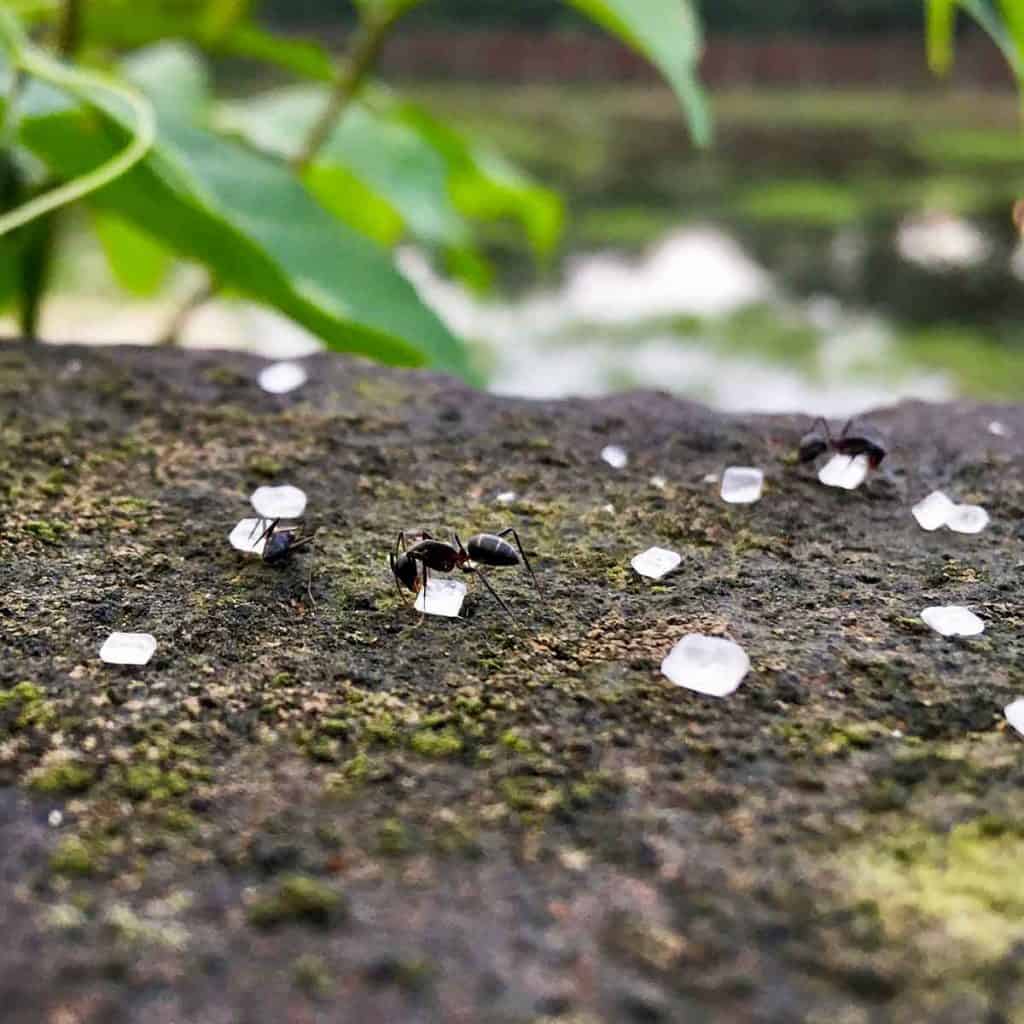
Best Sugar Ant Killer Products
The right and effective ant killers you can buy mean less hassle mixing and setting one up yourself.
Best Liquid Ant Bait:
TERRO T300B Liquid Ant Killer

The liquid bait is one of the three types of ant bait you can use to poison and kill an ant colony. It contains borax as the active ingredient.
You may see more ants initially as the bait draws ants to it, but expect to see a decreasing number of ants in 2 to 3 days.
What you get with this ant bait:
- Enclosed station design prevents accidental consumption by pets.
- Contains borax.
- Pre-filled and ready to use.
- Attracts and kills all common household ants.
- Choice of 6 or 12 bait stations.
Best Gel Ant Bait:
Syngenta TRTD11568 Gel Ant Bait with Plunger

The gel form in a plunger is handy when you need to set the bait in places a bait station cannot fit.
Monitor as the ants deliver poison to the colony and kill them in their nest, and the ant numbers drop.
What you get with this ant bait:
- Plunger design allows for application in hard-to-reach areas, including wall cracks and crevices.
- Contains the active ingredient Thiamethoxam.
- For indoor and outdoor use.
- 4 tubes pack.
Best Granular Ant Bait:
Advance 375A Granular Ant Poison Bait

Most ant baits are sugar-based, but the Advance granular bait is protein-based.
Setting up 2 bait stations – one sugar and one protein-based – helps you test which type the ants love more and pick a winner that you can always depend on.
Start with a small amount on the ants’ path and monitor the take-up rate.
What you get with this ant bait:
- Protein-based poison bait.
- Attracts and kills all common household ants.
- Weather-resistant; suitable for indoor and outdoor use.
- 8 oz packaging.
Best Outdoor Ant Spray:
Hot Shot HG-4480 Ant Killer

An insecticide spray is handy if you want to kill ants (or any crawling insects) on sight, but it will not exterminate the colony.
Always keep the room naturally-ventilated when spraying indoors.
Insecticide sprays typically have a strong odor. Identify the ants’ entry points, spray the wall gaps and crevices, and around the door or window frames from outside the house to prevent ants from entering.
What you get with this ant killer:
- Kills on contact.
- Kills ants and other insects.
- Water-based, but expect a strong smell.
- For indoor and outdoor use.
How Do Sugar Ants Appear Out of Nowhere?
It must be puzzling when sugar ants still appear despite your best efforts in keeping your home clean.
Sugar ants use their chemical sensing system to detect sugar and foods. When they find food crumbs or scraps, they will haul the food back to the nest while depositing pheromones along the route, which the other ants use as a guiding trail back to that same source. Even if a sugar ant colony exists outside your house and only one sugar ant stumbles upon the food source, they will return in droves, making you feel that sugar ants appear out of nowhere.
When Are Sugar Ants Most Active?
Sugar ants are a common household pest that enters your home searching for food and water. The worker ants look for food and protect their home, while the queen’s single role is to lay eggs to expand the colony.
Sugar ants are most active during the warmer months of the year. They are not particularly affected by bright or dark surroundings but leave their nest to forage for food during the day. That is why you seldom see sugar ants at night.
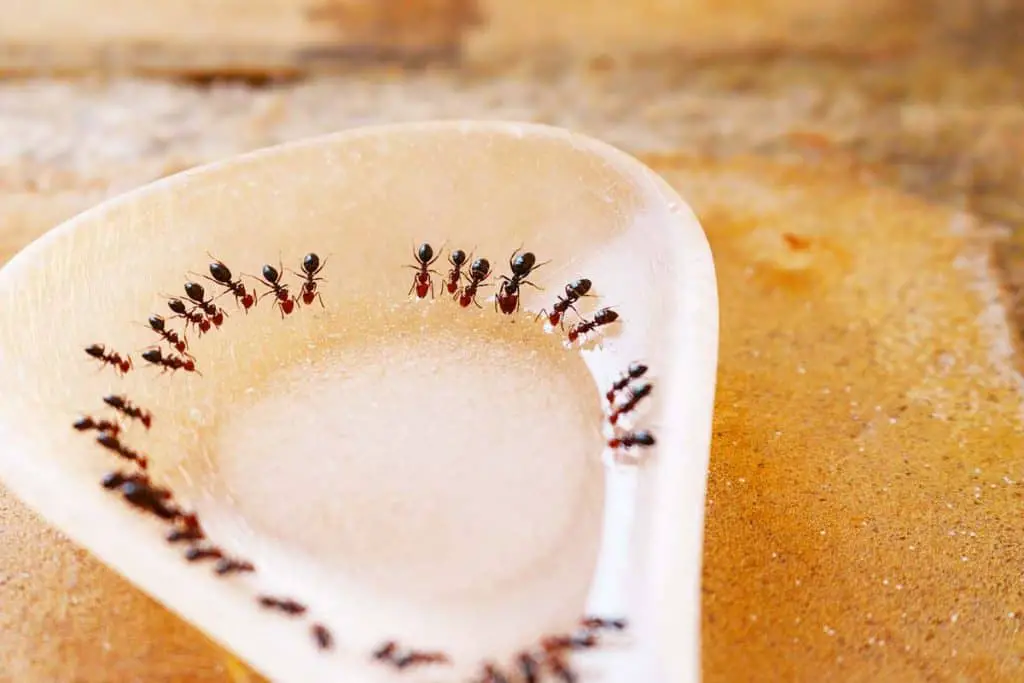
What Kills Sugar Ants?
Sugar ants are a typical problem homeowners face. The ants can locate food sources without fail once they find food in your house the first time, and you neglect the necessary steps to prevent them from returning.
(see the final section below on sugar ant prevention)
There will be instances when you need to kill them on sight.
The everyday household items that can kill sugar ants include:
- Vinegar – white vinegar or apple cider vinegar.
- Bleach.
- Diatomaceous earth.
- Borax (or boric acid) and sugar 1:4 mixture.
- Baking soda and sugar 1:1 mixture.
- Rubbing alcohol.
- Most other cleaning detergents.
- Salty water spray – will prevent but not kill sugar ants.
Most ingredients listed above kill visible sugar ants on contact but are ineffective when attempting to exterminate a colony where the queen nests and continues to lay eggs.
Why Do Sugar Ants Smell Like Chemicals?
Sugar ants give off an odorous chemical when you squash them. The smell signals danger to the other ants and briefly attracts more of them as they investigate the cause. Their presence alone will not stink.
Unlike fire ants, sugar ants do not have a stinger, and if you kill one of them, the other ants will not attack you.
How to Prevent Sugar Ants Naturally?
You can kill ants, but you can never completely get rid of an ant population. The world is their playground – it has been so long before humans roamed the earth.
Your solution is long-term preventive actions – remove their food source, and the sugar ants will have no reason to return.
How to Clean to Prevent Ants?
You don’t need a “magic” cleaner for the surfaces you need to clean to prevent ants. The key to keeping an ant-free home is thoroughness and consistency.
Keep a clean environment indoors and outdoors consistently to prevent ants:
- Do not leave dirty dishes in the sink overnight; wash them after each meal.
- Clean the kitchen counter after each meal preparation with a wet cloth and liquid dishwashing soap (no fancy cleaner necessary; use what you already have next to the sink).
- Take out the trash daily; if you have sweet food in it, empty the trash can immediately after your food preparation.
- Sweep the floor regularly, particularly if you think there are food crumbs after a meal.
- Mop the floor with a cleaner at least once a week to remove ant pheromones, if any.
- Wipe and clean immediately after a drink spill.
- Remove and clean pet feeding tray daily.
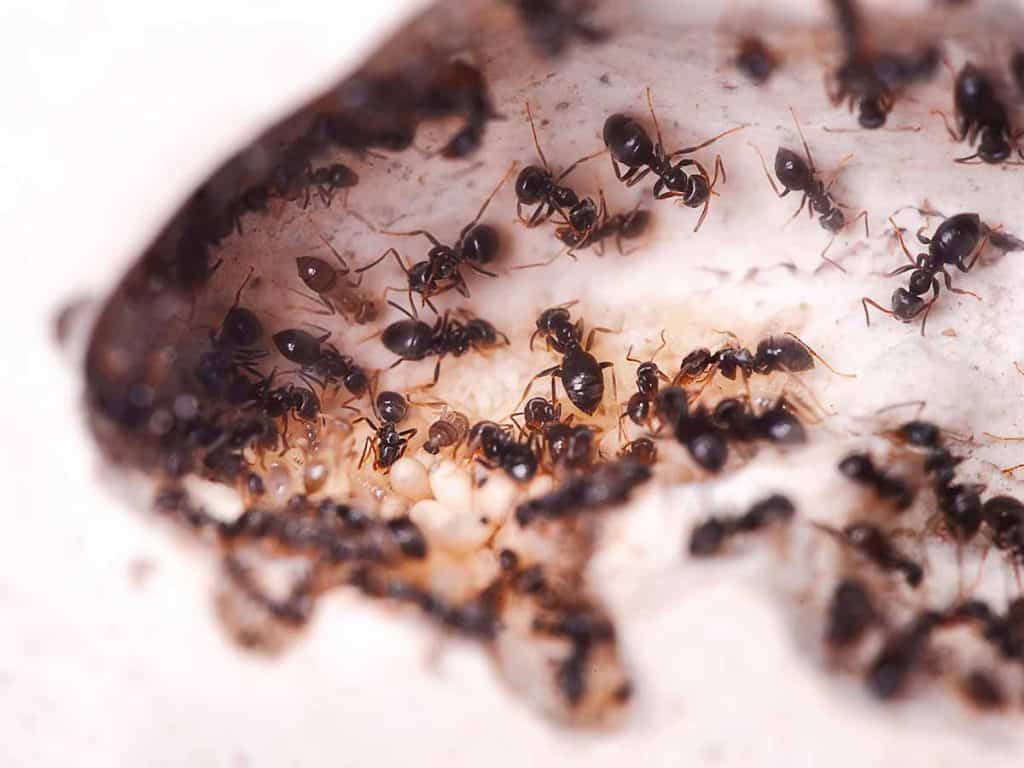
How to Store Sugar to Prevent Ants?
Sugar is one of the ants’ primary targets.
Proper sugar storage to prevent ants include:
- Store sugar in an air-tight container with a screw-top lid, or
- If you store it in a container with a lock-down lid, make sure it has an even rubberized seal around it.
- If you keep a small spoon in the sugar jar, use one short enough so you can always close the jar tightly.
- Keep remaining sugar in the original packaging tightly sealed in the refrigerator.
How to Store Honey to Prevent Ants?
Honey is another favorite for the sugar ants – it is the premium sweet food for most ants.
Most homeowners don’t want to refrigerate honey to maintain its quality, making proper storage in the cabinet or countertop crucial.
Keeping ants away from your honey requires care:
- Store the honey in an air-tight container or jar.
- Each time you take the honey out, wipe around the container’s opening with a clean and damp cloth before securing the lid; then wipe the container’s wall and base thoroughly to remove any honey stain.
- Place the jar on a paper towel.
- Store it in a cool place away from sunlight.
How to Seal Cracks to Prevent Ants?
No barrier is too difficult to overcome for ants foraging for food. They will find any crevices in the walls or gaps in the door and window frames.
Seal cracks in the wall to prevent ants:
- Use either a premixed caulk compound in an applicator or silicone sealant for a waterproof seal.
- Fill the crevices and gaps thoroughly from top to bottom.
- Wipe off excess compound with a damp paper towel to level the seal.
Besides sealing the cracks, you need to adopt the best cleaning practices (listed above) to keep the ants at bay. Otherwise, the ants will simply find another way to enter.
Will Coffee Grounds Keep Sugar Ants Away?
You can spread used coffee grounds to repel ants, but without keeping the kitchen clean and dry and taking out the trash daily, your efforts will be in vain.
Ants are hardy insects that thrived on earth longer than humans did. Your coffee grounds are no match for hungry ants getting to an inviting food source indoors.
Further, it is impractical to spread coffee grounds around your house and to do so regularly.
Will Sugar Ants Go Away on Their Own?
Sugar ants typically nest in the ground and potted plants but venture into your home for food and water. Remove the sources that attract them – and keep it that way consistently – and the sugar ants will go away on their own.
